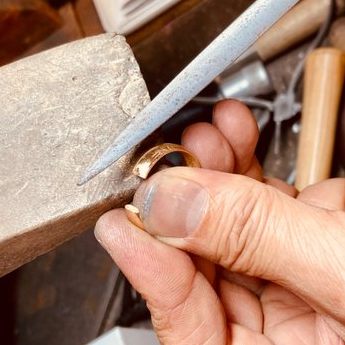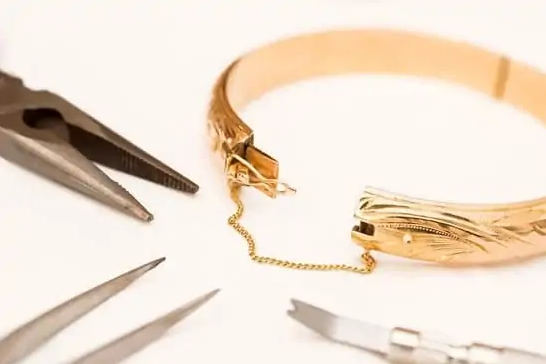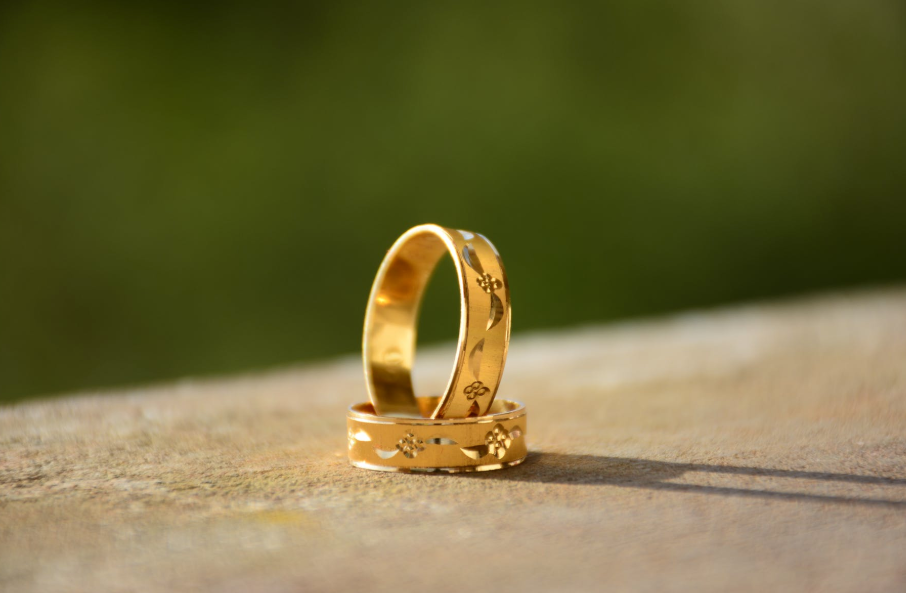With its dazzling allure and timeless elegance, gold-plated jewelry has captivated fashion enthusiasts and fans for decades.
This exquisite adornment combines the luxury of gold with the affordability of base metals, offering a perfect blend of style and economy.
Gold plating involves the application of a thin layer of genuine gold onto a base metal, creating a luxurious finish that mimics solid gold at a fraction of the cost.
As such, it has become a staple in jewelry collections worldwide, adorning necklaces, bracelets, earrings, and more, serving as a symbol of sophistication and a statement of personal style.
In this comprehensive article, we will delve into the world of gold-plated jewelry, exploring what it is, and its enduring popularity. We will also cover the importance of proper maintenance to preserve its lustrous appearance.
Understanding the Basics of Gold Plating
Understanding the basics of gold plating unveils the artful transformation of base metals into stunning, golden jewelry pieces. This intricate process begins with meticulous surface preparation, eliminating impurities to ensure a flawless foundation for gold adhesion.
Electrocleaning further refines the metal, while a striking layer acts as a bridge between the base metal and the gold, enhancing adhesion.
The actual gold plating occurs as the metal, immersed in a solution with dissolved gold ions, forms a lustrous, thin layer of gold through electroplating.
The thickness of this layer can vary, offering flexibility in achieving the desired appearance. Post-plating finishing touches like polishing elevate the jewelry’s aesthetic, resulting in the coveted elegance of gold-plated treasures that, with proper care, can endure as timeless symbols of beauty and affordability.
The gold plating process
The gold plating process is a meticulously crafted technique that imparts a luxurious layer of gold onto the surface of a base metal or alloy, transforming it into a shimmering work of art. This process typically unfolds in several key stages:
- Surface Preparation: The journey begins with thoroughly cleaning and preparing the base metal. Contaminants, such as dirt, oils, or oxide layers, are meticulously removed through ultrasonic cleaning or acid baths. This step is critical to ensuring the gold adheres firmly to the metal surface.
- Electrocleaning: To further purify the metal surface, it undergoes electrocleaning; an electrical current is applied while the metal is immersed in a specialized cleaning solution. This step eliminates any remaining impurities, creating an ideal surface for gold adhesion.
- Rinsing: Following cleaning and electro-cleaning, the metal is thoroughly rinsed to eliminate any traces of cleaning agents or residues, ensuring a pristine surface.
- Striking: To enhance adhesion, a thin layer of another metal, often nickel or silver, is applied to the prepared metal surface. This intermediary layer, known as a “strike,” is a bonding agent, improving the connection between the base metal and the gold layer while preventing the base metal from diffusing into the gold.
- Gold Plating: The heart of the process involves immersing the prepared metal into a solution containing dissolved gold ions. An electrical current is applied, prompting the gold ions to adhere to the metal surface, forming a fragile but captivating layer of pure gold.
- Finishing: After the gold plating procedure, the piece often undergoes additional finishing touches, such as polishing and buffing. These final steps elevate the jewelry’s appearance, enhancing its shine and texture and ensuring it meets the desired visual standards.
Factors that can cause wear and tear
Despite its inherent allure, gold-plated jewelry is not impervious to the passage of time and the rigors of daily use.
When it comes to these exquisite adornments, understanding the specific factors that contribute to wear and tear becomes crucial in preserving their lustrous charm and longevity.
1. Surface Friction and Constant Contact
Gold-plated jewelry, often intimately worn, frequently encounters friction and contact with the skin, clothing, and various surfaces.
Such persistent interaction can gradually diminish the gold plating, especially in areas subject to frequent rubbing or pressure, such as the rings’ inside or the bracelets’ clasps. Over time, this wear becomes noticeable as the once-gleaming gold begins to thin.
2. Chemical Exposure and Tarnishing
Everyday life exposes gold-plated jewelry to various substances, including lotions, perfumes, and household cleaning agents.
Some of these chemicals can react with the gold plating, leading to tarnishing, discoloration, or a dull appearance. This chemical wear is a reminder of the importance of removing jewelry before engaging in activities involving potentially harmful substances.
3. Moisture and Humidity’s Impact
The level of moisture and humidity in the environment can affect gold-plated jewelry. Excessive moisture and high humidity levels can cause the jewelry to tarnish or lose its luster.
This is particularly relevant for pieces worn in humid climates or during water-related activities like swimming or bathing.
4. Abrasion and Surface Scratches
Gold-plated jewelry is susceptible to abrasion when it comes into contact with rough or abrasive surfaces or materials.
For example, wearing a gold-plated necklace with a rough-textured sweater or scarf may lead to surface scratches and wear, compromising its visual appeal.
5. Sweat and Body Oils Accumulation
The natural oils and sweat produced by the body can accumulate on gold-plated jewelry over time, leading to a buildup of residue that can detract from its shine. Regular cleaning is necessary to remove this buildup and maintain the jewelry’s brilliance.
6. Proper Storage Considerations
How gold-plated jewelry is stored also plays a role in its longevity. Keeping multiple pieces together without proper protection, such as individual pouches or compartments, can result in contact-induced abrasions and damage.
7. Quality of Gold Plating
Lastly, the quality of the gold plating itself is a crucial factor influencing wear and tear. Higher-quality plating is generally more durable and less prone to deterioration, while lower-quality plating may wear away more quickly.

Signs that Your Gold-Plated Jewelry Needs Restoration
While enchanting and cost-effective, gold-plated jewelry may require periodic restoration to retain its exquisite appearance. Recognizing the signs that your cherished pieces need attention can ensure they continue to shine and dazzle. Here are some key indicators to watch for:
Discoloration or fading
One of the most conspicuous signs that your gold-plated jewelry needs restoration is a noticeable change in its color.
Over time, exposure to the elements, environmental factors, and the oils from your skin can cause the vibrant gold hue to fade, leaving the jewelry looking lackluster and discolored.
This gradual fading can occur due to natural oxidation, prolonged wear, or contact with substances like lotions and perfumes.
If your once-gleaming jewelry has lost its luster and appears dull or discolored, it’s a clear signal that restoration is to bring back its radiant charm.
Scratches and dents
The wear and tear of daily life can result in surface imperfections that mar the beauty of your gold-plated jewelry.
Small scratches, scuffs, or dents can accumulate over time, diminishing the piece’s overall appeal.
These blemishes may occur due to accidental bumps, contact with abrasive surfaces or even friction from other jewelry pieces.
Seeing visible scratches or dents on your jewelry that cannot be easily buffed out with regular cleaning is a sign that restoration is necessary.
Professional restoration can help smooth the surface, reducing or eliminating these imperfections and restoring the jewelry to its original splendor.
Peeling or flaking of the gold layer
One of the distressing signs of wear and tear in gold-plated jewelry is the occurrence of peeling or flaking of the gold layer.
This phenomenon refers to the gradual separation of the thin layer of gold from the underlying base metal.
As the gold layer begins to detach, it exposes the base metal beneath, resulting in visible patches of diminished luster and an overall compromised appearance.
Peeling or flaking can be particularly evident in areas subjected to constant friction, such as the edges of rings or the links of bracelets, where the gold plating is most vulnerable.
This issue affects the aesthetic appeal of the jewelry and highlights the urgency of restoration to ensure the integrity of the piece and restore its original splendor.
Materials and Tools Required
The restoration of gold-plated jewelry demands meticulous attention to detail, and to embark on this transformative journey, you must be armed with suitable materials and tools.
A well-equipped restoration process is the key to resurrecting the radiance and charm of your cherished pieces.
Here’s an exhaustive list of the essential materials and tools that will form the backbone of your restoration toolkit, enabling you to address an array of issues that may have marred the jewelry’s appearance over time:
Soft cloth
At the core of your jewelry restoration toolkit lies a soft, clean cloth that’s gentle and effective.
This unassuming fabric is your primary weapon against the accumulated dirt, oils, and residues that may have dulled the surface of your gold-plated jewelry.
Its soft, non-abrasive texture is the first defense against potential scratches or harm to the delicate gold plating, rendering it an indispensable component in your restoration arsenal.
Mild soap and water
As you embark on your journey to breathe new life into your treasured jewelry, you’ll need the assistance of a mild soap, preferably one of the gentle dishwashing varieties, and lukewarm water.
This dynamic duo forms the foundation of your jewelry cleaning regimen.
Their combined might is invaluable in dissolving away oils, grime, and the stubborn residue that may have accumulated on your jewelry’s surface, obscuring its brilliance.
This mild soap and water solution is the essential first step in preparing your jewelry for the meticulous restoration process that awaits.
Soft-bristled toothbrush
Restoring gold-plated jewelry often demands attention to intricate details and access to those hard-to-reach nooks and crannies.
Here’s where the soft-bristled toothbrush comes into play. This unassuming but highly effective tool is your trusted companion for gently scrubbing away the remnants of time from your jewelry.
Its soft bristles ensure that you can navigate the jewelry’s complex design without causing any harm or abrasions to the delicate gold plating.
With this tool in your hands, you’re well-equipped to restore your jewelry’s original brilliance and charm.
Gold cleaning solution (optional)
For those instances when your gold-plated jewelry requires more than just a standard cleaning, having a specialized gold cleaning solution in your toolkit can be a game-changer.
This optional addition to your arsenal is handy when faced with heavy tarnish or stubborn residue that standard cleaning may struggle to remove.
It offers an extra layer of cleaning power, specifically formulated to address the unique needs of gold-plated jewelry.
While optional, this solution can elevate your restoration efforts to the next level, ensuring that even the most stubborn blemishes are effectively dealt with.

Gold polishing cloth
A gold polishing cloth is another indispensable tool in your quest to restore the jewelry’s former glory.
This specialized cloth is designed to buff and polish the gold-plated surface, effectively removing tarnish, restoring shine, and imparting a renewed brilliance to your jewelry.
Its soft texture and inherent polishing properties make it an excellent finishing touch to your restoration process.
Re-plating kit (for those wanting to go the extra mile)
If you’re committed to taking your jewelry restoration to the highest level of excellence, a re-plating kit is a valuable addition to your toolkit.
This kit typically includes the necessary chemicals and tools for reapplying a fresh layer of gold plating to your jewelry, effectively restoring it to its original glory.
While this step requires more skill and effort, it can breathe new life into heavily worn or damaged pieces, allowing you to cherish them for years.
Step-by-Step Guide to Restore Gold-Plated Jewelry
The journey of restoring your gold-plated jewelry is a truly gratifying endeavor, one that has the power to infuse new vitality into your treasured pieces and rekindle their timeless allure.
This comprehensive step-by-step guide is your trusted companion, elucidating the intricate process of revitalizing the jewelry’s inherent beauty.
From the gentle, deliberate cleaning to the optional yet transformative advanced restoration techniques, each step is a deliberate gesture towards preserving the physical aesthetics of your jewelry and the invaluable memories and emotions it encapsulates.
By following these meticulous guidelines, you embark on a journey of both care and reverence that celebrates the enduring significance of your gold-plated jewelry and ensures it continues to dazzle and resonate with the moments and sentiments it represents.
a. Cleaning the Jewelry
- Create a mild, soapy solution with lukewarm water and gentle dishwashing soap.
- Submerge the jewelry in soapy water and gently scrub the surface and intricate areas with a soft-bristled toothbrush.
- Rinse the jewelry under lukewarm water to remove soap, then pat dry with a soft cloth.
b. Polishing the Jewelry
- Use a gold polishing cloth designed for jewelry to gently buff the entire surface in circular motions until the desired shine is restored.
c. Advanced Restoration: Re-plating (Optional)
- Choose an appropriate re-plating kit for your jewelry’s needs.
- Carefully follow the instructions in the kit, which typically include applying a fresh layer of gold plating.
- During re-plating, adhere to safety guidelines and precautions outlined in the kit’s instructions to ensure a safe and successful restoration.
Tips and Tricks for Prolonged Shine
Ensuring your gold-plated jewelry maintains its exquisite shine and allure for an extended period involves careful practices and thoughtful maintenance.
Here, we delve into some invaluable tips and tricks that will help you safeguard the radiant beauty of your cherished pieces.
Storing jewelry properly: in a cool, dry place and separate from other jewelry
At the heart of preserving your jewelry’s enduring splendor is meticulously considering how it’s stored during its moments of respite.
The art of jewelry preservation begins with consciously choosing a suitable storage environment.
To safeguard your cherished gold-plated treasures from premature wear and the insidious onset of tarnishing, selecting a calm, dry sanctuary away from the harsh embrace of direct sunlight and excessive moisture is imperative.
The perils of prolonged exposure to humidity and sunlight cannot be overstated, as they can potentially hasten the degradation of the delicate gold plating.
Beyond location, it is worth delving into the finer details of storage methodology, contemplating the wisdom of keeping each piece distinct and separate.
Employing individual pouches or compartments further fortifies this protective fortress, shielding your jewelry items from potential friction-induced scratches and the vexing menace of tangling.
This seemingly elementary yet remarkably effective precaution transcends simplicity to stand as a guardian of your jewelry’s pristine condition, ensuring that each piece remains as untarnished and lustrous as the day you first acquired it.
Avoiding exposure to chemicals, like perfumes and lotions
Chemical substances, including fragrances, lotions, and abrasive cleaning agents, can significantly threaten the longevity of your gold-plated jewelry’s shine.
These compounds have the potential to react with the gold plating, resulting in unsightly discoloration or even damage to the finish.
To mitigate this risk, adopt a practice of applying perfumes and lotions before adorning your jewelry.
Allow these products to fully dry on your skin before donning your pieces. This approach reduces the chances of direct contact between the chemicals and the jewelry, preserving its brilliant appearance.
Moreover, when engaging in household cleaning tasks or other activities involving harsh chemicals, it is advisable to remove your jewelry entirely to shield it from potential harm.
By remaining vigilant about chemical exposure, you are taking a proactive step in safeguarding the enduring splendor of your jewelry collection.
Taking off jewelry while swimming or showering
While adorning your jewelry at all times may be tempting, removing it before engaging in activities like swimming or showering is prudent.
This choice is grounded in the awareness that substances encountered in such environments, such as chlorine in swimming pools or the chemical compositions of soaps and shampoos, can pose a particular threat to delicate gold plating.
The protracted exposure to these agents has the potential to initiate tarnishing and corrosion, which, over time, can erode the jewelry’s sheen and structural integrity.
To shield your treasured pieces from these potential hazards, it is advisable to take off your jewelry before plunging into the pool’s refreshing waters or embarking on a cleansing shower.
This seemingly minor yet profoundly significant precaution serves as a protective barrier, preserving your jewelry’s pristine condition and ensuring it retains its captivating brilliance for years to come.
Regularly cleaning the jewelry even if not tarnished
Embracing a proactive stance towards maintaining your precious jewelry entails the conscientious practice of regular cleaning, a prudent course of action even when there are no conspicuous indications of tarnish or diminishing luster.
This dedicated care routine protects against the gradual accumulation of oils, residues, and minuscule particles that can gradually erode the jewelry’s radiant facade over time.
To perform this essential upkeep, immerse your gold-plated treasures in a brief and gentle bath of lukewarm, soapy water and employ a soft toothbrush to dislodge contaminants delicately.
After this tender cleansing, rinse the jewelry meticulously and thoroughly dry it.
This consistent regimen of regular cleaning not only perpetuates your jewelry’s dazzling allure but also acts as a preemptive measure, significantly reducing the likelihood of requiring more extensive and time-consuming restoration processes.
Conclusion
The essence of restoring and meticulously maintaining gold-plated jewelry extends beyond its mere visual allure; it embodies the preservation of both its physical and sentimental value.
Throughout this journey of exploration, we have unearthed the profound connection between the care bestowed upon these adornments and the timeless memories and emotions they symbolize.
Beyond being ornamental, gold-plated jewelry serves as a custodian of our life’s stories, invoking cherished moments that grow more precious with each passing day.
It is paramount to recognize the pivotal role we play as stewards of these legacies, for by tending to and protecting these treasures, we grant them the power to transcend time and convey our narratives to future generations.
All jewelry fans should embrace the duty of vigilant maintenance, as it extends the lifespan of these pieces and ensures they continue to gleam radiantly, preserving the enduring significance of the memories and sentiments they represent.
Thus, let us not only revel in the inherent beauty of our gold-plated jewelry but also honor the timeless value of the moments they encapsulate, forging an eternal link between past, present, and future.



